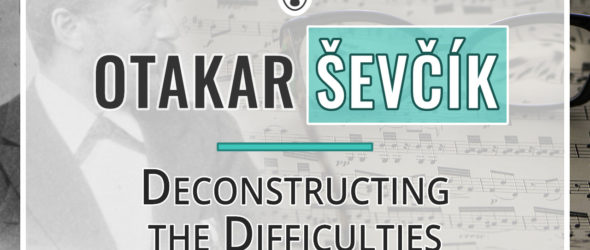Read on to learn all about Otakar Ševčík (often written as Sevcik), one of the most influential violin teachers.
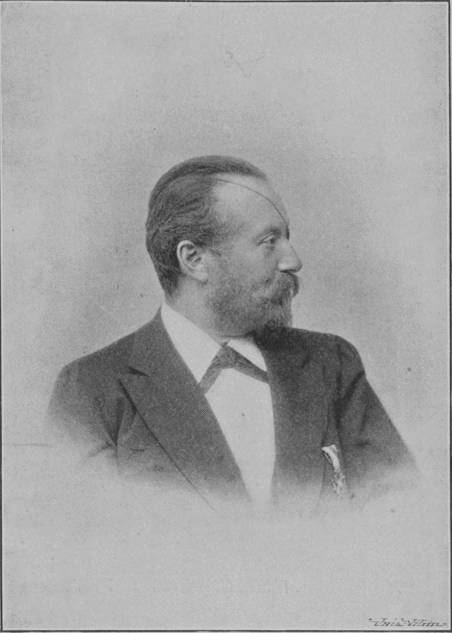
When you “hit a wall,” any teacher should try to deconstruct and rearrange the thing that causes it in a much easier way. Technical difficulties might seem tough or even dishearten you so that you feel like you can’t make it, but breaking them up into their most fundamental parts and working your way step by step through them is the most efficient way to overcome them. In the history of the violin, there’s no one else known better for this analytical manner than Otakar Ševčík.
Life and Career of Otakar Sevcik
Ševčík was born in the Austrian Empire, in Horažďovice, which today is in the Czech Republic.
He took his first music lessons from his father, the local schoolmaster. He then studied at the Prague Conservatory. One of his teachers was then well-known violinist, teacher, and composer Hans Sitt.

Throughout his life, Ševčík was a concertmaster in the Mozarteum concerts, the Prague National Theater, and the Komische Opera at the Ring Theatre in Vienna, and he was performing solo at the music school of the Russian Music Society in Kyiv.
He taught at Mozarteum and the Russian Music Society in Kyiv, and became head of the violin department at the Prague Conservatory while also teaching privately. He then became director of the Violin Department at the Vienna Music Academy and the Imperial Royal Academy of Music in Vienna. Later, Ševčík traveled to the United States and Great Britain as a well-known teacher.
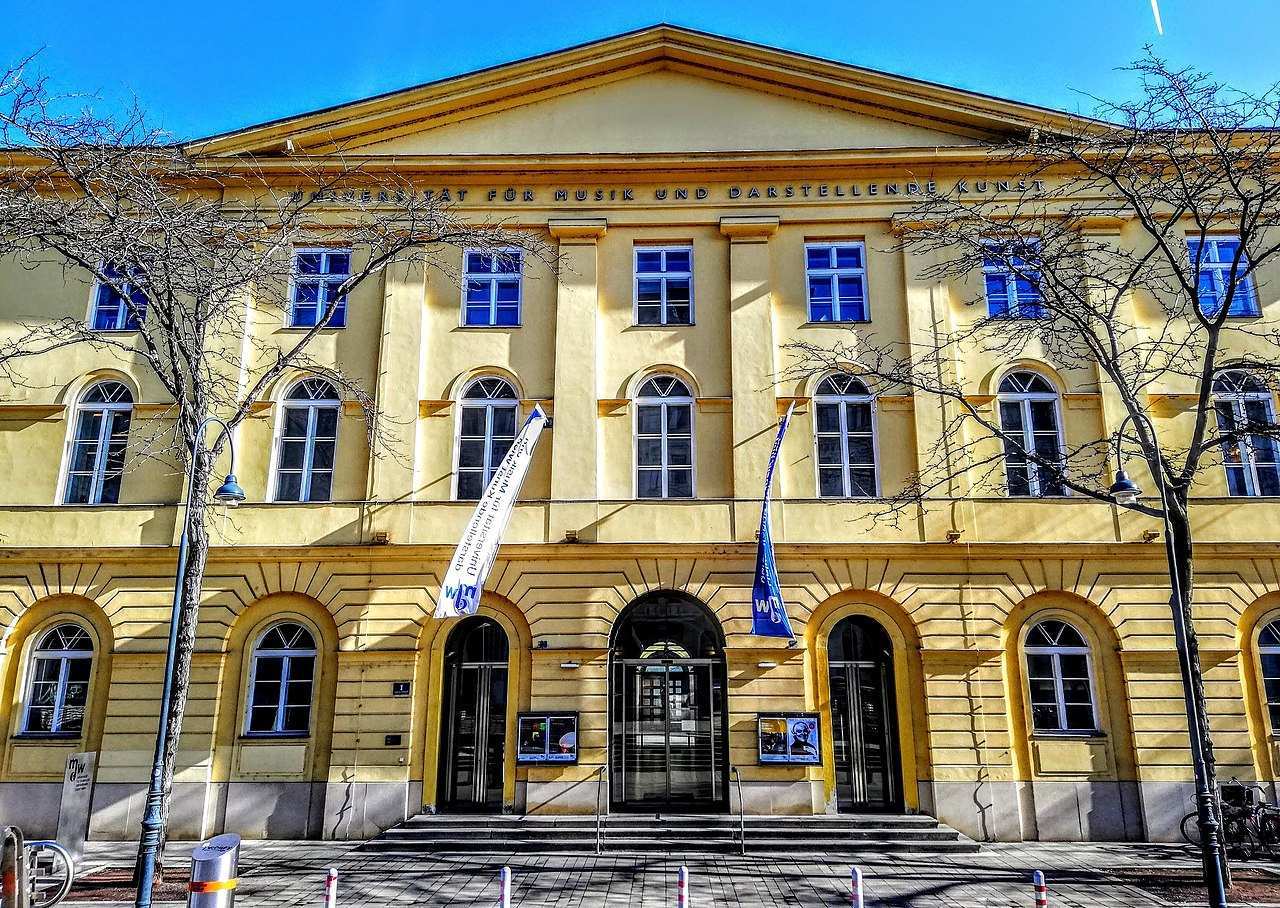
His development of the semitone system left a lasting influence. He died in 1934 and in his old age, he donated his property to the Ševčík College, an institution he founded to support young musicians.
His resume is surely impressive but this is not the reason he is famous among violinists. It’s because his works are so valuable and a great help to any violinist!
Fun (?) Fact
Ševčík lost his eye from a disease when he was studying in Prague.
Before the internet age, a common urban legend was that he lost his eye because the E string snapped. This is probably where the common legend originates that you can lose your eye if a string snaps. This is very unlikely to happen if you were wondering.
Otakar Ševčík – School of Violin Technics
Ševčík’s contribution to the violin repertoire is his many books covering all aspects of the violin technique. Bowing technique, changes of positions, trill exercises, double stops, and more are included. But the real genius of those books is the way the exercises are presented.
While Ševčík’s exercises are similar to the School of Violin Techniques by Schradieck, they are more analytical, breaking down the desired task into smaller, easier parts. Then, the exercises require the student to persistently play through all possible positions and finger configurations.
His work is categorized into 24 opuses, each might include one or several books. Some of them have been arranged for viola and cello. So, it’s not an exaggeration to say that his complete work can fill a small bookcase.
Read on to find the complete list of Sevcik’s works and get those that suit you best!
The “Cheat Sheets” for Violin Playing by Otakar Ševčík
One of his most important contributions, which is not widely spread, is his “cheat sheets” for various well-known and difficult concertos. Those were out of print since the 1930s, but new editions are becoming available in the last couple of years.
The “elaborate” or “analytical” studies on concertos and other violin compositions, including Wieniawski and Paganini concertos among others, take the deconstructing approach to the practical level.
The books include exercises that go measure by measure, breaking down the difficult parts and providing exercises to master them. To give you a clue, it’s like when you study a passage first at a slow tempo and then increasing it step by step. It’s like this but taken to the extreme, for very difficult and virtuosic passages, and explained them as simply as possible.
This is a must for any advanced student or young professional.
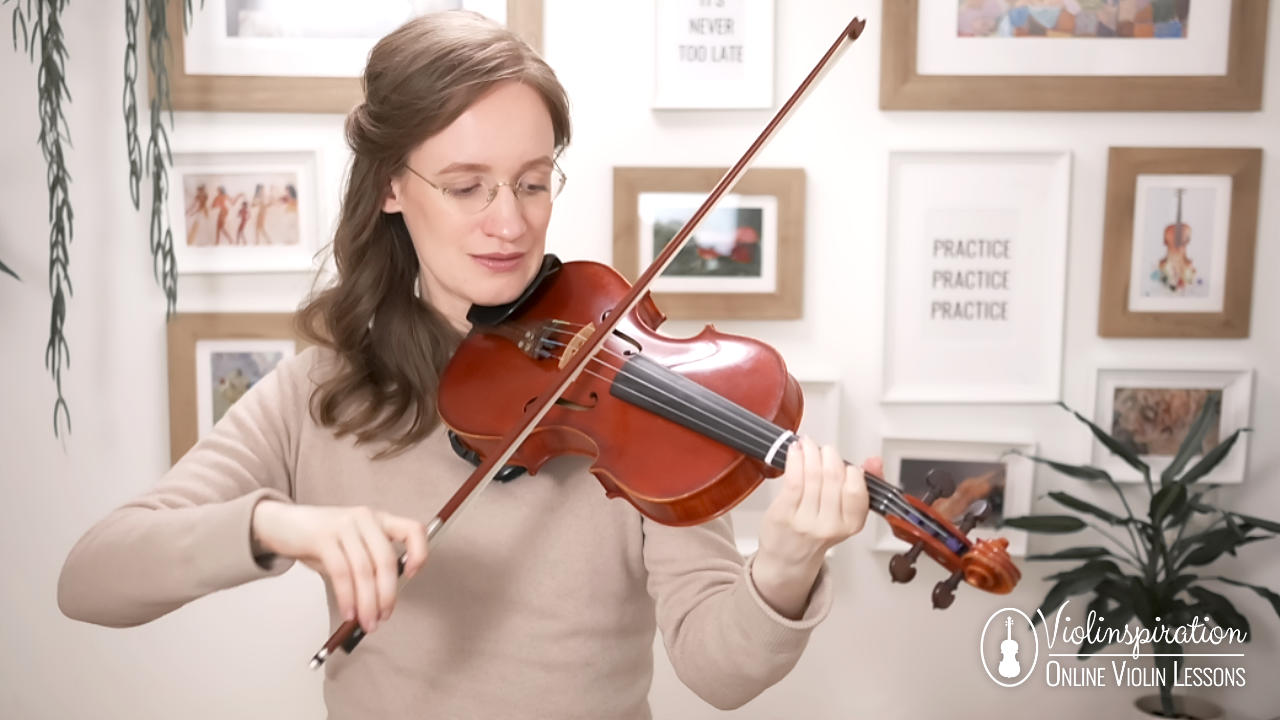
Now, let’s have a look at all works by Sevcik. Download the books for free below, or use the links to Amazon to buy printed books.
All Works of Otakar Ševčík
Here’s a complete list of Sevcik’s works, as well as some remarks on the level of difficulty and what kind of exercises you may expect.
Op. 1, School of Violin Technique
Sevcik’s School of Violin Technique consists of 4 books: one in the first position which is best for all beginners, and the rest with exercises in the 2nd, 3rd, 4th, 5th, 6th, and 7th positions, as well as shifting and double stops which are best for intermediate and advanced students.
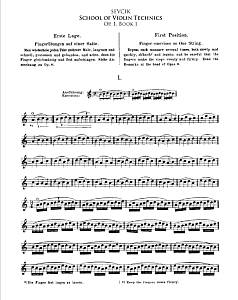
School of Violin Technics Op. 1, Book 1 by Sevcik
Free Violin Sheet Music
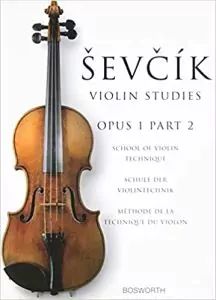
School of Violin Technique Op. 1, part 2 by Otakar Ševčík
Free Violin Sheet Music
Op. 2, School of Bowing Technique
The School of Bowing Technique has 6 books, all about bowing techniques. It’s for beginner and intermediate students.
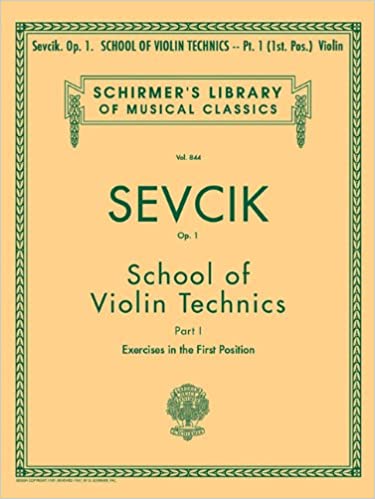
School of Violin Technique Op. 2 by Otakar Ševčík
Support us for more FREE content No extra costs for you Recommended by Violinists
Op. 3, 40 Variations – from the Violin Studies
The collection of 40 Variations is a supplement for Op. 2.
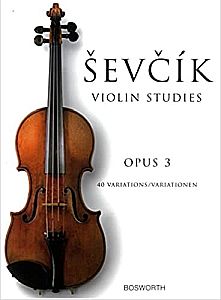
Sevcik – Violin Studies Op. 3 – 40 Variations
Free Violin Sheet Music
Op. 4, Expansion of the Fingers
Opus no. 4 is as all about stretching and other exercises for extending all fingers (other than the first). It’s best for advanced students.
Op. 5, Preparation for 24 Etudes or Caprices
A book that will prepare you in the best way possible for the etudes by Jacob Dont. For advanced students.
Op. 6, Violin School for Beginners
7 books for beginner students covering exercises in the 1st position mostly, but has two books dedicated to the 2nd – 5th position, as well as trills and double stops.
Op. 7, Violin Studies
The subtitle of this book is the following: Studies Preparatory to the Shake & Development in Double-Stopping. In this opus, you will find all possible exercises for playing trills, also with the use of the double stops.
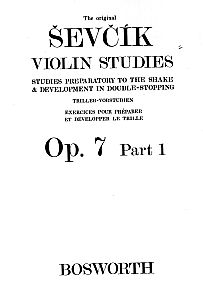
Violin Studies, Op. 7 by Otakar Ševčík Book 1 and 2
Free Violin Sheet Music
Op. 8, Changes of Position and Preparatory Scale Studies in 3 Octaves
As the title suggests, this covers changing positions. A useful book for anyone working on this subject. It’s highly recommended for practice by intermediate students.
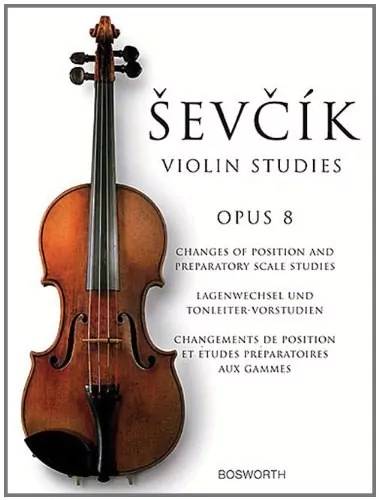
Otakar Ševčík – Violin Studies – Op. 8
Changes of Position and Preparatory Scale Studies
Free Violin Sheet Music
Op. 9, Preparatory Exercises in Double-Stopping for the Violin
If you’d like to learn double stops, make sure to practice exercises from this book! It includes practicing various intervals: seconds, thirds, fourths, sixths, octaves, tenths, and there are also harmonics.

Sevcik – Op. 9 Preparatory Exercises in Double-Stopping
Free Violin Sheet Music
some more text here
Op. 10, 6 Czech Dances and Airs for violin and piano
A collection of compositions for advanced students based on national and popular Czechoslovakian songs.
Op. 11, School of Intonation on an Harmonic Basis for Violin in 14 parts
This work covers the basics but can be useful for an intermediate student too.

School of Intonation on an Harmonic Basis for Violin in XIV Parts, Op.11
Support us for more FREE content No extra costs for you Recommended by Violinists
Op. 12, School of Double Stopping
This publication is highly unlikely to be found, as it is out of print for many decades now, or was never published. The same applies to the following works.
Op. 13, School of Arpeggios and Modulations
Op. 14, School of Chords
Op. 15, School of Flageolets (Harmonics) and Pizzicatos
Op. 16, School of Interpretation for the Violin
Opus 16 covers 45 pieces of the violin repertoire, analyzing etudes, concertos, and other compositions, from Rode and Fiorillo to Paganini and Beethoven. It can be used as early as improver (experienced beginner) to advanced students and beyond.
Op. 17, Elaborate Studies on Wieniawski’s 2nd Violin Concerto
This is one of the Sevcik’s “cheat sheets.” The Wieniawski concerto is very demanding so it’s best suited for advanced students.
Op. 18, Analytical Studies for Concerto in D Major, Op. 77 by J. Brahms
Next cheat sheet, but now for the Brahms concerto. It was published in one book together with op. 25.
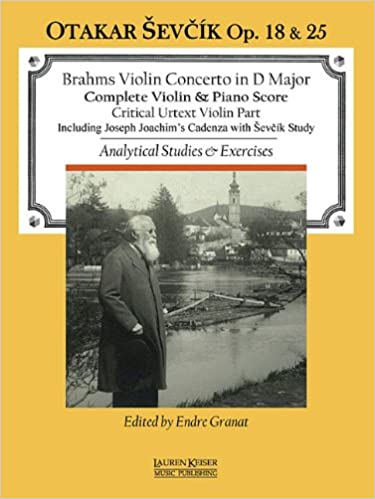
Analytical Studies for Concerto in D Major
Support us for more FREE content No extra costs for you Recommended by Violinists
Op. 19, Elaborate Studies and Analysis bar to bar to P. I. Tchaikovsky Op.35 Concerto in D Major
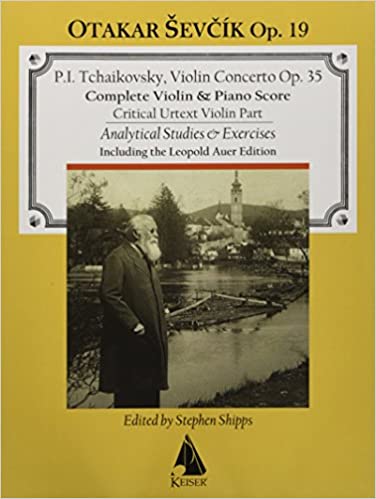
Elaborate Studies and Analysis bar to bar to Tchaikovsky Op. 35
Support us for more FREE content No extra costs for you Recommended by Violinists
The famous violinist David Oistrakh said the following about Op.19:
“Otakar Ševčík is proposing studies not only for managing technical difficulties of the Concerto but also for mastering the rhythmical harmony of the performance. This is especially important while performing the Concerto with orchestral accompaniment. A lot of attention is paid to these studies, and also to the exactness and logic of dynamic nuances of performance.”
Op. 20, Elaborate Studies and Analysis of Paganini Allegro Concerto No. 1 in D Major
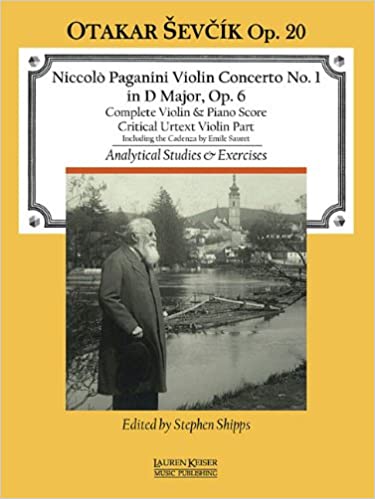
Op. 20, Elaborate Studies and Analysis of Paganini Allegro Concerto
Support us for more FREE content No extra costs for you Recommended by Violinists
Op. 21, Analytical Studies for Concerto in E Minor, Op. 64 by F. Mendelssohn
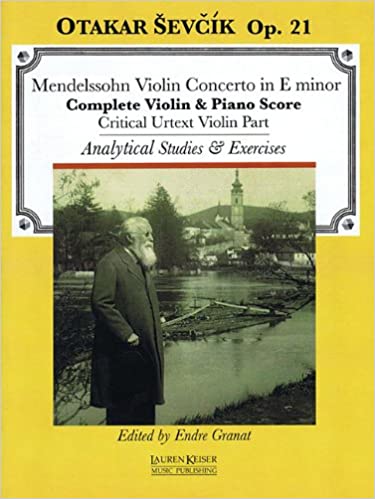
Violin Concerto in E minor with analytical studies and exercises, Op. 21
Support us for more FREE content No extra costs for you Recommended by Violinists
Op. 22, Change of Positions in Single and Double Stoppings
Difficult or impossible to find as only the manuscript is available.
Op. 23, Chromatics in all positions (Manuscript)
Op. 24, Left Hand Pizzicato with Simultaneous Right Hand Arco Technique
This was published fairly recently, in 2005. This technique is only for advanced students.
Op. 25, Studies on the Cadenza for Brahms’ Concerto by Joachim
This only covers the cadenza for Brahms’ concerto by famous Hungarian violinist, Joseph Joachim.
Op. 26, Analytical Studies for Etudes-Caprices by R. Kreutzer
4 books of exercises based on the etudes by Rodolphe Kreutzer.
Analytical Studies for Concerto in A, Op. 53 by Antonín Dvořák
Unfortunately, it hasn’t been published.
The Nopp Table – Works by Sevcik Divided by Difficulty
Viktor Nopp was a Czech military officer, violinist, and music teacher, born in 1893. Outside of his military career, he studied violin in Vienna with well-known teachers of the time, before meeting Sevcik and becoming his assistant. From 1946 to 1957 he was a professor at the Brno Conservatory where some of his students became famous violinists. He also composed a small number of music pieces.
Nopp created a table that contains almost all of Ševčík’s work, organized by difficulty. It is divided into 8 levels. It is a helpful tool to take advantage of the Ševčík method in its entirety. You can download the Nopp table in PDF as prepared and translated by Tomáš Jamník from the Ševčík Academy over here:

Nopp Table – Ševčík’s work, organized by difficulty
Free Download
How to Study Ševčík
However valuable, Ševčík is very hard to study because his violin studies can be really irritating!
While he has written for beginner students, it’s probably better to venture into this territory if you are an intermediate or advanced student, and even then the beginner exercises will still be beneficial! Alternatively, if you are a young learner or an adult beginner but can dedicate some extra time & effort, you can definitely try them out. For sure, they will be beneficial for you if you’re interested in building the technique step by step.
Here are 4 tips that will make your practice more tolerable and fruitful.
Be careful about the intonation and articulation
Don’t just play! You have to be very careful to hit the notes correctly and do exactly what is in required in each exercise. Just playing through the exercise won’t be sufficient to earn the technique. Be focused on the task given, while being very precise. If you approach it the smart way, those exercises will benefit you greatly!
Learn the basics first
You have to have good posture and know the basics first. Those exercises are much better for reinforcing your skills rather than building them up with no preparation, so make sure to first check out my easy guides and video lessons on the technique you’d like to learn, and then proceed to Sevcik’s études.
Use easy Sevcik exercises as a warm-up
Use Ševčík much like you use scales or other warm-up exercises. A nice goal is to do them ca. 10 – 20 minutes per day.
They are quite repetitive, so you might get fatigued if you keep on playing. Also, focus on just a couple of exercises per day, no more than five. If you feel you can’t concentrate more, stop and go to the next item on your practice plan.
Change things up!
There is so much diversity, so you can include several of his books in your practice schedule, depending on what other things you have to practice, or what you want to achieve. For example, you can study the first position on one day and the next day try some bow exercises.
Feeling Overwhelmed?
Understandably, you might feel overwhelmed with the information and maybe even the Nopp Table is not helping much. This is how you can make good use of Ševčík’s semitone system:
Focus on what you want to improve. Maybe some bowing exercises? Opus 2 is what you’re looking for. Shifting is not your best quality? Try opus 8. If you need to develop your left hand, try opus 6. Maybe double stops trouble you? Opus 9 will help you a lot!
The most commonly used are Op. 2, Op. 6, Op. 8, and Op. 9. These four alone can widen your horizon and you’ll be able to discover his way of teaching and understand his analytical approach, which will be really helpful for anything else you are going to study.
If you’d like to get feedback on playing Sevcik’s exercises, you can upload your video over here – Julia’s Violin Academy students only.
Final Notes
Ševčík made his mark in violin history with his very thorough method. Each exercise is crucial to understand the mechanics of violin playing and its techniques. They can be annoying but if you are certain about your goals regarding playing the violin, they will help you tremendously, and if you are already playing an advanced repertoire or a young professional, they can help you maintain and improve your skills.
